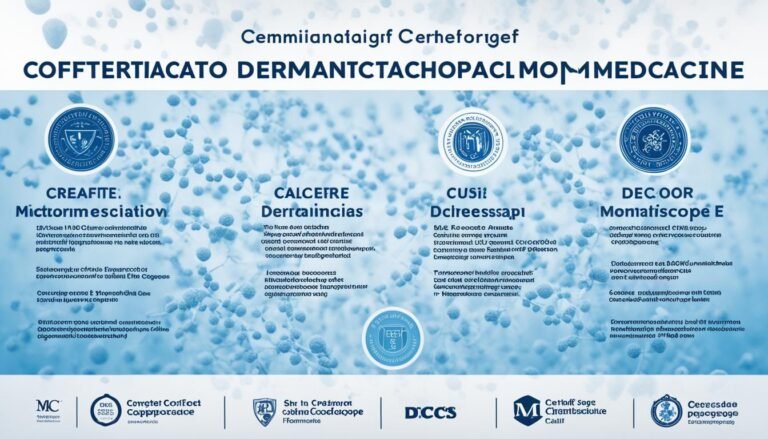A Guide to the Certified Risk Adjustment Coder (CRC) Certification
Risk adjustment coding is key in getting healthcare funds right, affecting billions yearly. Certified Risk Adjustment Coders (CRCs) use their skills to correctly assign diagnostic codes. These codes are crucial for patient care and financial success. If you’re thinking about a risk adjustment coding career or want to move up, getting CRC certified is a must.
Key Takeaways:
- A CRC certification is valuable for individuals pursuing a career in risk adjustment coding.
- Meeting the eligibility requirements and passing the CRC certification exam are essential steps in the certification process.
- Study materials such as the CRC Study Guide and online practice exams can help you prepare for the certification exam.
- Being a certified CRC opens up enhanced job prospects and career advancement opportunities.
- Accurate diagnosis coding and a strong understanding of medical terminology are vital in risk adjustment coding.
CRC Certification Requirements
To become a Certified Risk Adjustment Coder (CRC), you need to meet some requirements. These rules make sure you have the skills and knowledge to do well in medical coding.
You must have two years’ experience in medical billing and coding. This is because real-world practice is important for understanding risk adjustment coding’s ins and outs.
Also, knowing medical terms, anatomy, and how the body works is a must. These things help you figure out the right diagnosis codes and understand medical records.
Getting extra training is also a good idea. Look for programs approved by AAPC or AHIMA. They offer special courses in risk adjustment coding.
After you meet these requirements, you can take the CRC certification exam. Passing the exam shows you’re a skilled Risk Adjustment Coder. This opens many doors in the medical coding field.
Becoming a Certified Risk Adjustment Coder takes hard work and a love for precise coding. By doing what’s needed and learning all you can, you’ll succeed in this field.
Study Materials for the CRC Certification Exam
Passing the CRC certification exam is much easier with the right study materials. AAPC’s CRC Study Guide is a top pick for preparing. It covers everything you need to know for the test.
This guide dives deep into important topics. It also offers real-world examples and questions to check your skills. This helps boost your confidence and understanding.
Online practice exams are also key. They mimic the actual test and show how ready you are. After taking them, you’ll know what areas to focus on for improvement.
Benefits of Using Study Materials and Resources
“The CRC Study Guide and practice exams offer a systematic way to get ready. They let you build a strong base in risk adjustment coding. This makes passing the exam more likely.”
Using resources like the CRC Study Guide is a smart choice. They ensure you cover all you need to know. Plus, they’re flexible, so you can study at your own pace.
It’s smart to invest in quality study materials for the CRC exam. They help you really understand the topics. And they make your overall study plan better.
Recommended Study Materials:
- CRC Study Guide – AAPC
- Online Practice Exams
- Additional Review Books and Resources
Benefits of CRC Certification
CRC certification can lead to many more job prospects in risk adjustment coding. It makes those who hold it stand out for their knowledge in coding. Let’s check out why getting certified is such a good move:
Career Advancement: Once you’re CRC certified, you’ll find doors opening. Your knowledge in risk adjustment coding becomes proof to employers of your expertise. This can help you move up in your current job or find better ones easily.
Validation of Skills: Getting the CRC certification shows how skilled you are in coding. It proves that you are always trying to learn and grow in your profession. Companies in the healthcare field will find you very valuable because of it.
Industry Recognition: CRC certification is well-respected in healthcare. It shows employers that you can make sure documentation is correct and help get funds. Having it can make networking and building your career easier.
Continued Growth: Risk adjustment coding changes all the time with new rules and trends. Keeping your CRC means always learning and staying current. This shows you’re dedicated to your job and helps you grow professionally.
Higher Earning Potential: With a CRC certification, you could earn more in this coding field. Employers see you as more valuable, so your pay and benefits might get better. It’s a smart move to invest in your career this way.
Overall, being CRC certified brings many perks in risk adjustment coding. It can help with moving up, earning more, and getting known in the industry. This is why many professionals see it as a game-changer in their career in healthcare.
The CRC Certification Process
Getting the CRC certification is a journey with key steps. It’s about becoming a skilled risk adjustment coder.
Fulfilling the Eligibility Requirements
You have to meet specific criteria to be eligible for the CRC certification. This includes two years of experience in medical billing and coding. You also need knowledge of medical terms, body parts, and disease processes. Taking a training program approved by AAPC or AHIMA is a must.
Studying for the Exam
Preparing well is crucial for the CRC certification. Study hard using the CRC Study Guide from AAPC. It’s full of info and practice questions. Also, take online practice exams to better your skills.
Taking the Certification Exam
When you’re ready, it’s time for the CRC certification exam. This test your risk adjustment coding skills. It checks if you can assign the right diagnostic codes. Passing the exam is a big step to becoming a certified coder.
After passing, you’ll earn the Certified Risk Adjustment Coder (CRC) title. This shows you’re an expert in risk adjustment coding. It opens doors to varied career opportunities in healthcare.
| Benefits of CRC Certification | Why Pursue CRC Certification? |
|---|---|
| Enhanced job prospects | Expanding career opportunities |
| Career advancement potential | Recognition for specialized expertise |
| Commitment to ongoing education and development | Elevated professional status |
Remember these benefits as you work towards your CRC certification. They highlight the great career chances and respect you’ll earn in risk adjustment coding.
Preparation for the CRC Certification Exam
Getting ready for the CRC certification exam is key to doing well. You should use a mix of study materials and tools to make sure you’re ready.
The CRC Study Guide: Issued by AAPC, this guide covers everything you need to know. It has clear explanations, examples, and practice questions about risk adjustment coding.
Online Practice Exams: Practice exams online are a smart move. They let you see how the real test feels and the kind of questions you’ll face.
Recommended Resources: Besides the study guide and practice exams, AAPC suggests more aids. These can be books, online classes, webinars, or joining study groups.
It’s crucial to manage your time well when studying. Make a schedule that covers all parts of the exam. Pay extra attention to topics you find difficult.
Tips for Effective Exam Preparation
- Start studying early to give yourself enough time.
- Break your study time into smaller parts, focusing on one topic at a time.
- Regular practice with questions and exams is essential for improvement.
- Study with others who are also taking the CRC exam for insights.
- Keep your study materials organized to save time.
- Focus on self-care, including good sleep and nutrition, to be at your best.
Following these tips and using the resources suggested will prepare you well for the CRC exam.
Exam Preparation Checklist
| Task | Status |
|---|---|
| Obtain the CRC Study Guide from AAPC | Completed |
| Take online practice exams | In progress |
| Review recommended resources | Pending |
| Create a study schedule | In progress |
| Join a study group | Pending |
Note: Use the table to keep track of your progress. Change the tasks as needed to fit your study plan.
Preparation is everything for the CRC exam. Use the right materials and methods to study. Be dedicated and you’ll do great.
The Role of a Certified Risk Adjustment Coder
Being a Certified Risk Adjustment Coder (CRC) is very important. You make sure that the right codes are used for patients. This helps accurate payment and shows how sick someone is.
Your main goal is getting the coding right. You look at what makes a patient’s condition serious. By doing this job well, you help the healthcare system run smoothly.
To be great at coding, you need to really understand it. You have to keep learning and know the latest info. This way, you can describe a patient’s health clearly.
The Responsibilities of a Certified Risk Adjustment Coder
As a CRC, you handle many key tasks:
- Reviewing medical records to pick out key diagnoses and procedures
- Choosing the best ICD codes for proper risk assessment
- Making sure codes are accurate and follow the rules
- Working with doctors and coders to fix any mistakes or unclear info
- Always learning to keep up with changes in the field
- Using technology for recordkeeping and coding efficiently
Being a CRC means more than just putting codes on records. You are essential for fair payment and better health care. Your work boosts the whole system, making sure everyone gets the right care.
Skills and Qualifications
| Skills | Qualifications |
|---|---|
| Know how to use ICD-10-CM codes well | Have at least two years in medical coding |
| Be very focused on details | Understand medical terms, body parts, and how the body works |
| Be good at solving problems and thinking things through | Complete a schooling program for coding |
| Be a good communicator and team player | Eager to keep learning and getting better at the job |
| Have worked with electronic health records before | Get your Certified Risk Adjustment Coder (CRC) certification |
The Growing Demand for CRCs
The demand for Certified Risk Adjustment Coders (CRCs) is growing fast. This growth is because the healthcare industry is focusing more on value-based care. With this change, the need for accurate risk adjustment coding is increasing. For those aspiring to have a rewarding career, there are many opportunities in this area.
Getting certified as a CRC is a big step to take advantage of this demand. CRCs are experts in risk adjustment coding. They help healthcare organizations code accurately. This helps with getting the right payments and assessing risks correctly.
Risk adjustment coding is very important in healthcare. It allows healthcare places to understand their patients’ health better. This knowledge helps them get the right funds and manage resources well. The work of CRCs leads to better patient care and quality healthcare.
There are many job opportunities for CRCs in places like hospitals and insurance companies. As the healthcare industry uses more data and focuses on population health, the need for CRCs will keep growing.
The Benefits of Obtaining a CRC Certification
Getting a CRC certification has many benefits. It shows you are an expert in risk adjustment coding. It also boosts your credibility and opens doors for better job positions.
It gives you a chance to learn with other CRC professionals. Plus, there are opportunities for ongoing education to keep you updated in your field.
Investing in a CRC certification can lead to a satisfying career. With the demand for CRCs rising, having this certification puts you in a good place to find stable and well-paying jobs.
Job Outlook for CRCs
CRCs have a bright future, with many chances for career growth. The Bureau of Labor Statistics expects jobs in this area to grow quickly.
The shift towards value-based care and better health for populations means more medical coding jobs. This means CRCs can enjoy job security, good pay, and a variety of job options.
With the right CRC certification and skills, a successful and meaningful career in medical coding is within reach. This career helps improve healthcare and patient health.
| Factors | Job Prospects for CRCs |
|---|---|
| Growing Demand for Risk Adjustment Coding | High |
| Industry Emphasis on Value-Based Care | High |
| Population Health Management Initiatives | High |
| Evolution of Healthcare Reimbursement Models | High |
| Healthcare Analytics and Data Management | High |
The Importance of Medical Terminology in Risk Adjustment Coding
Accurate diagnosis coding in risk adjustment coding is very important. It depends a lot on knowing medical terminology. This knowledge helps make sure that diagnoses are coded correctly. It ensures medical documents are full and right. Knowing medical terms well is key to coding patient health issues correctly. This has a big effect on how much is paid for healthcare and risk scores.
When coding for risk adjustment, medical coders process info from medical files. Then, they pick the right diagnosis codes. Understanding medical terms is vital for this. It lets coders talk about health issues more clearly. They can tell similar words apart. They know where in the body each problem is and what it means clinically.
Take “angina” and “anemia,” for example. Although they sound alike, they mean different health problems. Knowing their differences is vital for exact coding. Medical terms help coders avoid mix-ups. They make sure the patient’s health issues are described right. This makes risk coding precise.
Medical terminology boosts how well and how fast risk adjustment coding happens. A strong knowledge helps coders go through records quickly. They find the main points and assign the right codes. This speeds up their work and cuts down on mistakes. It saves time and effort in the long haul.
Medical terms are also key for risk adjustment scores to be right. Good and detailed notes are needed for correct risk scores. Coding with exact medical terms shows what the patient really has. This leads to correct risk scores. These scores are vital for how healthcare is paid for.
Key Takeaways:
- Medical terminology is at the heart of accurate diagnosis coding for risk adjustment.
- To assign the right codes for patient health conditions, a deep knowledge of medical terms is essential.
- Knowing medical terms well makes the coding process faster, more accurate, and improves risk score precision.
https://www.youtube.com/watch?v=lh993JUit_s
Conclusion
Getting a Certified Risk Adjustment Coder (CRC) certification is very beneficial. It helps those who want to work in risk adjustment coding. The process includes meeting set requirements, studying for the exam with suggested materials, and then, taking the exam.
After becoming certified, you’ll see many advantages. These include more job options, chances to grow in your career, and being recognized for your expert knowledge in risk adjustment coding.
FAQ
Q: What are the requirements to become a Certified Risk Adjustment Coder (CRC)?
Q: What study materials are available for the CRC certification exam?
Q: What are the benefits of obtaining a CRC certification?
Q: What is the process to become a Certified Risk Adjustment Coder?
Q: How should I prepare for the CRC certification exam?
Q: What is the role of a Certified Risk Adjustment Coder?
Q: Is there a growing demand for Certified Risk Adjustment Coders?
Q: Why is medical terminology important in risk adjustment coding?
Source Links
- https://www.aapc.com/shop/study-guides/crc-study-guide.aspx
- https://www.aapc.com/training-and-events/exam-preparation/crc-exam-preparation-course
- https://medassisting.org/certified-risk-adjustment-coder/

Our Healthcare Editorial Team is composed of subject matter experts and seasoned healthcare consultants who bring decades of combined experience and a wealth of academic qualifications. With advanced degrees and certifications in various medical and healthcare management fields, they are dedicated to supporting the personal and career development of healthcare professionals. Their expertise spans clinical practice, healthcare policy, patient advocacy, and public health, allowing us to offer insightful, well-researched content that enhances professional growth and informs practice.
Disclaimer
The client education section of our blog is intended to support healthcare providers by offering informational resources for patient education. However, this information is not meant to serve as medical advice. We advise healthcare professionals to ensure all content is consistent with their clinical knowledge and confirm with current medical standards before using it in their practice or advising patients. For specific medical issues, always refer to professional guidance and standards of care.
For any legal matters or specific medical concerns, we strongly recommend consulting with a qualified legal professional or referring to government websites for authoritative information.







